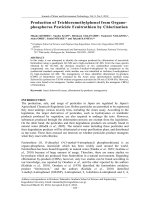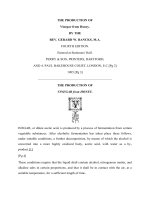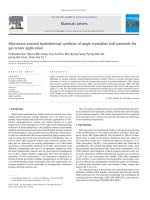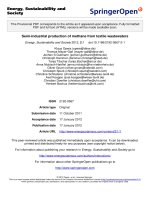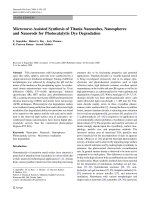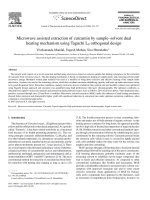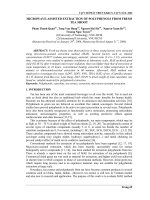Microwave assisted production of aggregates from demolition debris
Bạn đang xem bản rút gọn của tài liệu. Xem và tải ngay bản đầy đủ của tài liệu tại đây (3.66 MB, 294 trang )
MicrowaveAssisted Production
of Aggregates from Demolition
Debris
Ali Akbarnezhad
(B.Eng, Amirkabir University of Technology)
A THESIS SUBMITTED
FOR THE DEGREE OF DOCTOR OF PHILOSOPHY
DEPARTMENT OF CIVIL ENGINEERING
NATIONAL UNIVERSITY OF SINGAPORE
2010
i
Microwave-Assisted Production of Aggregates from Demolition Debris
ACKNOWLEDGEMENT
I would like to expresses my sincere gratitude to a number of people who have supported
and encouraged me during my graduate studies. I hope that the pages of this thesis can
serve as letters of “thanks” to the many individuals who have helped me bring it to
completion.
I am deeply indebted to my supervisor, A/Prof. Gary Ong Khim Chye whom his wealth of
knowledge and his attitude towards graduate student supervision contributed immensely
to my research efforts. Without his guidance, persistent help, and encouragement this
thesis would not have been possible.
I also wish to express my deepest gratitude and appreciation to A/Prof. Tam Chat Tim,
A/Prof. Zhang Min Hong and Mr. Timothy Wan Juang Foo for their invaluable advice
and guidance throughout the course of this research.
I would like to express my special thanks to all the staffs of the concrete and structural
laboratory of NUS, especially Mr. Ang Beng Oon, Ms. Annie Tan, Mr. Lim Huay Bak,
Mr. Kamsan Bin Rasman, Mr. Koh Yian Kheng and Mr. Choo Peng Kin for their kind
assistant and support during the experimental stage of this study.
I am also extremely thankful to my lovely wife whom meeting her was my most
significant achievement during my stay in Singapore.
Finally, this undertaking could never have been achieved without the encouragement and
love of my wonderful father, mother and sisters who have encouraged me and believed in
me from the earliest time I can remember.
And above all, I thank God for everything that I have experienced and achieved. I believe
that He always provides me the best of all things.
ii
Microwave‐Assisted Production of Aggregates from Demolition Debris
TABLE OF CONTENTS
ACKNOWLEDGEMENT ................................................................................................... ii
ABSTRACT...................................................................................................................... viii
LIST OF FIGURES ............................................................................................................. x
LIST OF TABLES ............................................................................................................. xx
LIST OF SYMBOLS ....................................................................................................... xxii
Chapter 1 : INTRODUCTION ........................................................................................... 1
1.1
Background ........................................................................................................... 1
1.2
Recycled Concrete Aggregate (RCA) vs. Recycled Aggregate (RA)................... 3
1.3
High-Quality Recycled Concrete Aggregate......................................................... 4
1.4
Elimination of Impurities\Contaminants ............................................................... 5
1.5
Removal of the Adhering Mortar .......................................................................... 7
1.6
Objectives .............................................................................................................. 8
1.7
Thesis Organization .............................................................................................. 9
Chapter 2 : Recycled Concrete Aggregate- Literature Review ........................................ 16
2.1
Concrete Recycling Technology- State of Art .................................................... 16
2.2
Properties of Recycled Concrete Aggregate (RCA) ........................................... 18
2.2.1
Amount of Adhering Mortar ........................................................................ 18
2.2.2
Density ......................................................................................................... 23
2.2.3
Water Absorption ......................................................................................... 24
2.2.4
Toughness (Abrasion and Impact Resistance) ............................................. 25
2.2.5
Soundness .................................................................................................... 26
2.2.6
Impurities ..................................................................................................... 27
2.3
Available Standards on RCA .............................................................................. 28
Chapter 3 : Proposed Methods to Improve the Quality of RCA ........................................ 42
3.1 Removal of Contaminants from the Surface of Concrete (Surface Decontamination)
....................................................................................................................................... 43
3.1.1 Abrasive Jetting ................................................................................................ 44
3.1.2 High Pressure Liquid Nitrogen Blasting ........................................................... 44
3.1.3 Wet Ice Blasting................................................................................................ 44
3.1.4 High Pressure and Ultra High Pressure Water Jets........................................... 45
3.1.5 Sponge Blasting ................................................................................................ 45
iii
Microwave-Assisted Production of Aggregates from Demolition Debris
3.1.6 CO2 Blasting (Dry Ice Blasting) ....................................................................... 45
3.1.7 Mechanical Scabbling ....................................................................................... 46
3.1.8 Electro-Hydraulic Scabbling............................................................................. 46
3.1.9 Drilling and Spalling ......................................................................................... 46
3.1.10 Grinding .......................................................................................................... 47
3.1.11 Shot Blasting ................................................................................................... 47
3.1.12 Soda Blasting .................................................................................................. 47
3.1.13 Laser Ablation................................................................................................. 47
3.1.14 Microwave Heating......................................................................................... 48
3.1.15 Previous Experiences on Using Microwave Heating as a Demolition Tool... 48
3.2. Removal of the Adhering Mortar from RCA Particles (RCA Beneficiation) ........ 52
3.2.1 Thermal Beneficiation ...................................................................................... 53
3.2.2 Mechanical Beneficiation ................................................................................. 53
3.2.4 Acid Pre-Soaking Beneficiation ....................................................................... 54
3.2.5 Chemical-Mechanical Beneficiation................................................................. 55
3.2.6 Microwave-Assisted Beneficiation ................................................................... 55
Chapter 4 : Fundamentals of Microwave Heating ............................................................. 63
4.1 Background .............................................................................................................. 63
4.2 Microwave Heating Mechanism .............................................................................. 66
4.3 Dielectric (Electromagnetic) Properties of Materials .............................................. 67
4.4 Reflection and Transmission of the Waves at Interfaces ......................................... 68
4.5 Penetration Depth & Attenuation Factor ................................................................. 69
4.6 Dielectric Properties of Concrete, Mortar and Aggregate ....................................... 70
4.7 Maxwell’s Equations ............................................................................................... 72
4.8 Electromagnetic Energy ........................................................................................... 74
4.9 Dissipated Radiative Energy .................................................................................... 75
4.10 Lambert’s Law ....................................................................................................... 76
4.11 Plane Wave Assumption ........................................................................................ 78
Chapter 5 : Microwave Decontamination of Concrete- Approximate Numerical
Simulation .......................................................................................................................... 96
5.1 Background .............................................................................................................. 96
5.2 Microwave Power Formulation: Modified Lambert’s Law ..................................... 99
5.2.1 Modifications for the Reflected Power ........................................................... 100
5.2.2 Modification for Microwave Modes ............................................................... 101
5.3 Problem Description .............................................................................................. 103
iv
Microwave‐Assisted Production of Aggregates from Demolition Debris
5.4 Formulation ............................................................................................................ 104
5.4.1 Heat Transfer and Thermal Stress Analysis ................................................... 104
5.4.2 Mass Transfer ................................................................................................. 106
5.4.3 Heat and Mass Transfer Boundary Conditions ............................................... 109
5.4.4 Structural Boundary Conditions ..................................................................... 110
5.5 Results and Discussions ......................................................................................... 110
5.5.1 Temperature Distribution ................................................................................ 111
5.5.2 Thermal Stresses ............................................................................................. 112
5.5.3 Pore Pressure................................................................................................... 112
5.5.4 Effect of Water Content .................................................................................. 113
5.5.5 Effect of Microwave Frequency ..................................................................... 113
5.5.6 Comparison with Available Literature ........................................................... 113
5.6 Conclusions ............................................................................................................ 115
Chapter 6 : Microwave Heating of Concrete-Accurate Numerical Simulation ............... 125
6.1 Background ............................................................................................................ 125
6.2 Industrial Microwave Heating Systems ................................................................. 127
6.2.1 Microwave Source .......................................................................................... 128
6.2.2 Waveguides ..................................................................................................... 129
6.2.3 Waveguide Fields ........................................................................................... 129
6.2.4 Waveguide Cutoff Frequency ......................................................................... 130
6.3 Problem Description .............................................................................................. 130
6.4 Problem Formulation ............................................................................................. 131
6.4.1 Power Dissipation: Maxwell’s Equation ........................................................ 131
6.4.2 Power Dissipation: Lambert’s Law ................................................................ 131
6.4.3 Heat Transfer .................................................................................................. 132
6.4.4 Structural Boundary Conditions ..................................................................... 133
6.4.5 Electromagnetic Boundary Conditions ........................................................... 133
6.4.6 Effects of the Reinforcing Bars ...................................................................... 135
6.5 Results and Discussions ......................................................................................... 135
6.5.1 Electric Field in Concrete ............................................................................... 136
6.5.2 Temperature Distribution ................................................................................ 137
6.5.3 Thermal Stresses ............................................................................................. 138
6.5.4 Effects of the Presence of Reinforcing Bars ................................................... 138
6.6 Conclusions ............................................................................................................ 138
v
Microwave-Assisted Production of Aggregates from Demolition Debris
Chapter 7 : Microwave-Assisted RCA Beneficiation- Numerical Simulation and
Preliminary Experiments ................................................................................................. 152
7.1 Different Electromagnetic and Thermal Properties ............................................... 153
7.2 Preliminary Experiments........................................................................................ 156
7.2.1 Experimental Procedure .................................................................................. 157
7.2.2 Results ............................................................................................................. 160
7.3. Numerical Study ................................................................................................... 162
7.2.1 Model Description .......................................................................................... 163
7.2.2 Formulation ..................................................................................................... 163
7.2.3 Results ............................................................................................................. 164
7.3 Conclusions ............................................................................................................ 166
Chapter 8 : Temperature Sensing in Microwave Heating of Concrete Using Fiber Bragg
Grating Sensors ................................................................................................................ 174
8.1 Background ............................................................................................................ 174
8.2 Temperature Sensors.............................................................................................. 178
8.2.1 Thermocouples................................................................................................ 178
8.2.2 Infrared Thermo Tracer Cameras (Radiation Thermometry) ......................... 179
8.2.3 Optical Fiber Sensor ....................................................................................... 179
8.3 Experiments ........................................................................................................... 184
8.3.1 Type of the FBG Sensors ................................................................................ 185
8.3.2 Calibration of FBG Sensors ............................................................................ 186
8.3.3 Instrumentation ............................................................................................... 186
8.3.4 Microwave Heating......................................................................................... 187
8.4 Numerical Modeling .............................................................................................. 187
8.5 Results and Discussions ......................................................................................... 188
8.5.1 Thermocouples Accuracy ............................................................................... 189
8.5.2 FBG Sensors ................................................................................................... 190
8.6 Conclusions ............................................................................................................ 191
Chapter 9 : Design and Installation of the 10 KW Microwave Heating System ............. 199
9.1 Configuration and Components ............................................................................. 199
9.1.1 The Microwave Generator Unit ...................................................................... 200
9.1.2 Power Delivery Unit ....................................................................................... 202
9.1.3 Cooling Unit ................................................................................................... 206
9.1.4 Control Unit .................................................................................................... 207
9.1.5 Microwave Heating Chamber ......................................................................... 209
vi
Microwave‐Assisted Production of Aggregates from Demolition Debris
9. 2 Assembly and Installation ..................................................................................... 211
9.2.1 Installation of Magnetron................................................................................ 211
9.2.2 Installation of the Cooling System.................................................................. 212
9.2.3 Waveguide Components ................................................................................. 212
9.3 Safety ..................................................................................................................... 213
9.3.1 Radiation Hazards ........................................................................................... 213
9.3.2 High Voltage Hazards ..................................................................................... 214
Chapter 10 : Experimental Investigation of the Effects of the Adhering Mortar Content
and Comparison of Various Beneficiation Methods........................................................ 228
10.1 Background .......................................................................................................... 228
10.2 Phase 1 Experiments ............................................................................................ 230
10.2.1. Relationship between RCA Properties and Adhering Mortar Content ........ 231
10.2.2 Effects of the Production Parameters on the Adhering Mortar Content of RCA
................................................................................................................................. 231
10.3 Phase 2 Experiments: Efficacy of Different RCA Beneficiation Methods.......... 233
10.3.1 Microwave-Assisted RCA Beneficiation...................................................... 234
10.3.2 Acid Soaking Beneficiation .......................................................................... 234
10.3.3 Conventional Heating Beneficiation (Thermal Beneficiation) ..................... 235
10.3.4 Measurement of the Delaminated Adhering Mortar Percentage .................. 235
10.4 Results and Discussion......................................................................................... 236
10.4.1 Phase 1 .......................................................................................................... 236
10.4.2 Phase 2: RCA Beneficiation Methods .......................................................... 239
10.5 Conclusions .......................................................................................................... 241
Chapter 11 : Summary, Conclusions and Future Work Recommendations .................... 250
11.1 Summary .............................................................................................................. 250
11.2 Conclusions .......................................................................................................... 254
11.3 Future Work Recommendations .......................................................................... 257
APPENDIX A: Mix Proportions and Mechanical Properties of Concrete ..................... 267
vii
Microwave-Assisted Production of Aggregates from Demolition Debris
ABSTRACT
Concrete recycling is an increasingly common method of disposing of demolition rubble
and can provide a sustainable source of concrete aggregates. However, Recycled Concrete
Aggregates (RCA) currently produced are usually of low quality and generally considered
not suitable for use in ready mix concrete. The presence of the contaminants (impurities)
in the concrete debris and the presence of the mortar adhered to the RCA particles have
been identified as the main causes lowering the quality of RCA compared to Natural
Aggregates (NA). The current study was aimed to investigate the possible methods to
eliminate the abovementioned causes and thereby increase the quality of RCA. Based on a
comprehensive literature review conducted to investigate the capability of different
surface removal techniques for removal of the contaminants from the concrete surface, the
focus was placed on the microwave decontamination technique that had been reported to
have a relatively better removal speed and performance. A comprehensive numerical
study was conducted to examine the phenomenon leading to delamination of the concrete
surface when exposed to microwaves and to develop an easy-to-use simulation technique
to be used in practical predictions and control of the microwave decontamination of
concrete. In addition, besides the concrete surface decontamination, a novel microwaveassisted technique to remove the adhering mortar from RCA was developed during the
current study. The capability of this method to remove the adhering mortar from RCA was
numerically and experimentally investigated and compared with the other RCA
beneficiation methods proposed in available literature. Moreover, an industrial microwave
heating system that can be used in concrete surface decontamination and RCA
beneficiation methods was designed and installed during the current study. The results of
viii
Microwave‐Assisted Production of Aggregates from Demolition Debris
this study demonstrated that incorporating the microwave-assisted decontamination and
RCA beneficiation techniques into the conventional concrete recycling procedure may
significantly increase the quality of RCA.
ix
Microwave-Assisted Production of Aggregates from Demolition Debris
LIST OF FIGURES
Figure 1.1 Price of Granite in Singapore Market (Statlink, 2010)..................................... 15
Figure 2.1Share of mortar for different RCA size fractions. (Fleischer and Ruby, 1998) 36
Figure 2.2 Share of mortar for different RCA size fractions. (De Juan et al., 2009) ......... 36
Figure 2.3 Jaw Crusher (www.sbmchina.com).................................................................. 37
Figure 2.4 Impact Crusher (www.impact-crushers.com)................................................... 37
Figure 2.5 The adhering mortar content of RCA measured through different techniques.
(De Juan et al., 2009) ......................................................................................................... 38
Figure 2.6 Variation of the bulk specific density of RCA with its adhering mortar content
(De Juan et al, 2009) .......................................................................................................... 38
Figure 2.7 Variation of the SSD density of RCA with its adhering mortar content (De Juan
et al., 2009) ........................................................................................................................ 39
Figure 2.8 Relationship between the water absorption and density measured for RCA
produced in four different recycling plants in Germany (RUHL and MARCUS, 1997) .. 39
Figure 2.9 Relationship between the water absorption and bulk density measured (De Juan
and et al., 2009).................................................................................................................. 40
Figure 2.10 Results of the RCA toughness tests conducted by Tabsh and Abdelfatah
(2009) ................................................................................................................................. 40
Figure 2.11Relationship between the Los Angles abrasion coefficient of RCA and its
adhering mortar content (De Juan and Gutierrez, 2009).................................................... 41
Figure 2.12 Results of the RCA soundness tests conducted by Tabsh and Abdelfatah
(2009) ................................................................................................................................. 41
Figure 3.1 Abrasive Jetting (www.mech.unsw.edu.au) ..................................................... 58
x
Microwave‐Assisted Production of Aggregates from Demolition Debris
Figure 3.2 Sponge Blasting (www.nstcenter.net) .............................................................. 58
Figure 3.3 CO2 Blasting (www.coldjet.com.au) ................................................................ 59
Figure 3.4 Shot Blasting (www.gritblasters.co.uk) .......................................................... 59
Figure 3.5 Microwave heating device for breakage of rocks (Puschner et al., 1965) ....... 60
Figure 3.6 Microwave assisted fracturing and cutting device for hard rocks (Invented by
Lindroth et al., 1991) ......................................................................................................... 60
Figure 3.7 Mobile system for microwave removal of concrete surfaces (Invented by White
et al., 1997) ........................................................................................................................ 61
Figure 3.8 “Heating and Rubbing” RCA Beneficiation Method (Tateyashiki et al., 2000)
........................................................................................................................................... 61
Figure 3.9 Acid Pre-Soaking RCA Beneficiation Method (Tam et al., 2006) .................. 62
Figure 4.1 Electromagnetic Spectrum................................................................................ 80
Figure 4.2 Concrete and Mortar Dielectric Constants (Hasted & Shah, 1964) ................. 80
Figure 4.3 Cole-Cole diagram for w/c=0.28 hardened cement paste at Vw (volume of
water)= 0.25,0.2,0.1. Full lines have been drawn arbitrarily through the closed circles,
which represent, from right to left, the data at λ=10, 3.33 and 1.25 cm (Hasted & Shah,
1964). ................................................................................................................................. 81
Figure 4.4 ε’ and ε” (Vw) for hardened cement paste specimens at λ=10 cm (Hasted &
Shah, 1964). ....................................................................................................................... 81
Figure 4.5 Typical ε’(T) and ε”(T) for water loaded hardened cement paste (closed
circles) and brick (open circles). Circles in parentheses are considered non-typical (Hasted
and Shah, 1964). ................................................................................................................ 82
Figure 4.6 Variation of concrete’s dielectric constant with temperature (Li et al, 1993). . 82
xi
Microwave-Assisted Production of Aggregates from Demolition Debris
Figure 4.7 Variation of concrete’s Loss Factor with temperature (Li et al, 1993) ............ 83
Figure 4.8 Dielectric constant of concrete at microwave frequency range, as reported by
H.C. Rhim et al. (1998)...................................................................................................... 83
Figure 4.9 Loss factor of concrete at microwave frequency range, as reported by H.C.
Rhim et al. (1998) .............................................................................................................. 84
Figure 4.10 Dielectric constant of mortar at microwave range, as reported by H.C. Rhim
et al. (1998) ........................................................................................................................ 84
Figure 4.11 Loss factor of mortar at microwave range, as reported by H.C. Rhim et al.
(1998) ................................................................................................................................. 85
Figure 4.12 Loss factor of coarse aggregate, sand and cement at microwave frequency
range, as reported by H.C. Rhim et al. (1998) ................................................................... 85
Figure 4.13 Dielectric constant of coarse aggregate, sand and cement at microwave
frequency range, as reported by H.C. Rhim et al. (1998) .................................................. 86
Figure 4.14 Loss tangent of concrete calculated using Equation 4.4................................. 86
Figure 4.15 Conductivity of concrete calculated using Equation 4.5 ................................ 87
Figure 4.16 Reflection coefficient of concrete calculated using Equation 4.6. ................. 87
Figure 4.17 Transmissivity of concrete calculated using Equation 4.7. ............................ 88
Figure 4.18 Brewester angle of concrete calculated using Equation 4.8 ........................... 88
Figure 4.19 Attenuation factor of concrete calculated using Equation 4.10...................... 89
Figure 4.20 Loss tangent of mortar calculated using Equation 4.4. .................................. 89
Figure 4.21 Conductivity of mortar calculated using Equation 4.5 ................................... 90
Figure 4.22 Reflection coefficient of mortar calculated using Equation 4.6 ..................... 90
Figure 4.23 Transmissivity of mortar calculated using Equation 4.7 ................................ 91
xii
Microwave‐Assisted Production of Aggregates from Demolition Debris
Figure 4.24 Brewester angle of mortar calculated using Equation 4.8. ............................. 91
Figure 4.25 Attenuation factor of mortar calculated using Equation 4.10......................... 92
Figure 4.26 Loss tangent of coarse aggregate, sand and cement calculated using Equation
4.4. ..................................................................................................................................... 92
Figure 4.27 Conductivity of coarse aggregate, sand and cement calculated using Equation
4.5. ..................................................................................................................................... 93
Figure 4.28 Reflection coefficient of coarse aggregate, sand and cement calculated using
Equation 4.6. ...................................................................................................................... 93
Figure 4.29 Transmissivity of coarse aggregate, sand and cement calculated using
Equation 4.7. ...................................................................................................................... 94
Figure 4.30 Brewester angle of coarse aggregate, sand and cement calculated using
Equation 4.8. ...................................................................................................................... 94
Figure 4.31 Attenuation factor of coarse aggregate, sand and cement calculated using
Equation 4.10. .................................................................................................................... 95
Figure 5.1 Sketch of the Microwave Decontamination System ...................................... 118
Figure 5.2 Temperature distribution in concrete after 5 seconds of microwave heating at
2.45GHz frequency .......................................................................................................... 118
Figure 5.3 Temperature distribution in concrete after 2 seconds of microwave heating at
10.6GHz frequency .......................................................................................................... 119
Figure 5.4 Temperature distribution in concrete after 1 second of microwave heating at
18GHz frequency ............................................................................................................. 119
Figure 5.5 Temperature distribution across the microwave incident surface of concrete
after 2 seconds of microwave heating at 10.6GHz frequency ......................................... 120
xiii
Microwave-Assisted Production of Aggregates from Demolition Debris
Figure 5.6 Radial compressive stress in concrete after 5 seconds of microwave heating at
2.45GHz frequency .......................................................................................................... 120
Figure 5.7 Radial compressive stress in concrete after 2 seconds of microwave heating at
10.6GHz frequency .......................................................................................................... 121
Figure 5.8 Radial compressive stress in concrete after 1 second of microwave heating at
18GHz frequency ............................................................................................................. 121
Figure 5.9 Radial compressive stress distribution across the microwave incident surface of
concrete after 2 seconds of microwave heating at 10.6GHz frequency ........................... 122
Figure 5.10 Pore Pressure in saturated concrete after 5 seconds of microwave heating at
10.6 GHz frequency ......................................................................................................... 122
Figure 5.11 Pore Pressure in saturated concrete after 3 seconds of microwave heating at
18 GHz frequency ............................................................................................................ 123
Figure 5.12 The variation of maximum compressive stress in concrete with frequency
after 1 second of microwave heating ............................................................................... 123
Figure 5.13 Comparison between the maximum temperatures in concrete obtained in this
study and the results reported by Bazant et al. for the same microwave frequency of 2.45
GHz and microwave incident power of 1.1 MW/m2 ....................................................... 124
Figure 5.14 Comparison between the maximum temperatures in concrete obtained in this
study and the results reported by Bazant et al. for the same microwave frequency of 10.6
GHz and microwave incident power of 1.1 MW/m2 ....................................................... 124
Figure 6.1 Sketch of the microwave applicator ............................................................... 141
Figure 6.2 Field lines for the TE10 mode in a rectangular waveguide ............................. 141
Figure 6.3 Boundary conditions....................................................................................... 142
xiv
Microwave‐Assisted Production of Aggregates from Demolition Debris
Figure 6.4 The z component of electric field inside concrete subjected to microwave at
2.45 GHz frequency and 1 W power. .............................................................................. 142
Figure 6.5 The z component of electric field inside concrete subjected to microwave at
10.6 GHz frequency and 1 W power. .............................................................................. 143
Figure 6.6 The z component of electric field inside concrete subjected to microwave at 18
GHz frequency and 1 W power. ...................................................................................... 143
Figure 6.7 Variation of the electric field’s norm inside concrete subjected to microwave at
2.45 GHz frequency and 1.1 MW/m2 power.................................................................... 144
Figure 6.8 Variation of the electric field’s norm inside concrete subjected to microwave at
10.6 GHz frequency and 1.1 MW/m2 power. .................................................................. 144
Figure 6.9 Variation of the electric field’s norm inside concrete subjected to microwave at
18 GHz frequency and 1.1 MW/m2 power....................................................................... 145
Figure 6.10 Temperature distribution in saturated concrete after 5 seconds of microwave
heating at 2.45 GHz frequency and 1.1 MW/m2 incident power .................................... 145
Figure 6.11 Temperature distribution in saturated concrete after 2 seconds of microwave
heating at 10.6 GHz frequency and 1.1 MW/m2 incident power ..................................... 146
Figure 6.12 Temperature distribution in saturated concrete after 1 second of microwave
heating at 18 GHz frequency and 1.1 MW/m2 incident power ........................................ 146
Figure 6.13 Temperature distribution across the heated zone of a saturated concrete after 5
second of microwave heating at 2.45 GHz frequency and 1.1 MW/m2 incident power.. 147
Figure 6.14 Temperature distribution across the heated zone of a saturated concrete heated
after 2 seconds of microwave heating at 10.6 GHz frequency and 1.1 MW/m2 incident
power ............................................................................................................................... 147
xv
Microwave-Assisted Production of Aggregates from Demolition Debris
Figure 6.15 Temperature distribution across the heated zone of a saturated concrete after 1
second of microwave heating at 18 GHz frequency and 1.1 MW/m2 incident power..... 148
Figure 6.16 Radial compressive stress in saturated concrete after 5 seconds of microwave
heating at 2.45GHz frequency and 1.1 MW/m2 incident power ..................................... 148
Figure 6.17 Radial compressive stress in saturated concrete after 2 seconds of microwave
heating at 10.6 GHz frequency and 1.1 MW/m2 incident power .................................... 149
Figure 6.18 Radial compressive stress in saturated concrete after 1 seconds of microwave
heating at 18 GHz frequency and 1.1 MW/m2 incident power ........................................ 149
Figure 6.19 Temperature distribution in reinforced saturated concrete after 5 seconds of
microwave heating at 2.45 GHz frequency and 1.1 MW/m2 incident power .................. 150
Figure 6.20 Temperature distribution in reinforced saturated concrete after 2 seconds of
microwave heating at 10.6 GHz frequency and 1.1 MW/m2 incident power .................. 150
Figure 6.21 Temperature distribution in reinforced saturated concrete after 1 second of
microwave heating at 18 GHz frequency and 1.1 MW/m2 incident power ..................... 151
Figure 7.1 The attenuation factors of coarse aggregate, sand, and cementitious mortar . 168
Figure 7.2 variation of the percentage of the adhering mortar removed with the sulfuric
acid concentration and soaking duration ......................................................................... 169
Figure 7.3 RCA particles before and after two minutes of microwave heating at 1.9 kW
power in a commercially available microwave oven....................................................... 169
Figure 7.4 Surface temperature of RCA particles after two minutes microwave heating at
1.9 kW in a commercially available microwave oven. .................................................... 170
Figure 7.5 The RCA beneficiation system considered for numerical simulation ............ 170
Figure 7.6 The RCA particle considered in numerical model ......................................... 171
xvi
Microwave‐Assisted Production of Aggregates from Demolition Debris
Figure 7.7
(a) Temperature, (b) Temperature gradient, (c) Normal stress, and (d)
Tangential stress in a saturated RCA particle subjected to microwave of 2.45 GHz
frequency and 10kW power ............................................................................................. 172
Figure 7.8
(a) Temperature, (b) Temperature Gradient, (c) Normal Stress, and (d)
Tangential Stress in an air dried RCA particle subjected to microwave of 2.45 GHz
frequency and 10kW power ............................................................................................. 173
Figure 8.1 Interior of the microwave oven ...................................................................... 194
Figure 8.2 (a) A commercially packaged FBG before microwave heating (b) burning of
the plastic coating next to the metallic splicer after microwave heating ......................... 194
Figure 8.3 Calibration curve for FBG1 ............................................................................ 195
Figure 8.4 Calibration curve for FBG2 ............................................................................ 195
Figure 8.5 Instrumentation of the concrete specimens; positioning of thermocouples and
FBG sensors ..................................................................................................................... 196
Figure 8.6 Sketch of the microwave oven for numerical modeling ................................. 196
Figure 8.7 . (a) Temperature profile captured using the infrared camera, (b) the specimen
under test, (c) embedded thermocouples’ readings, (d) temperature at the locations
monitored by thermocouples predicted using numerical modeling, (e) Temperature
measured using bare FBG sensors, (f) Temperature at the locations monitored by bare
FBG fibers predicted using numerical modeling, for a saturated concrete specimen (C3)
heated at 950W microwave power for 2 minutes. ........................................................... 197
Figure 8.8 (a) Temperature profile captured using the infrared camera, (b) the specimen
under test, (c) embedded thermocouples’ readings, (d) temperature at the locations
monitored by thermocouples predicted using numerical modeling, (e) Temperature
xvii
Microwave-Assisted Production of Aggregates from Demolition Debris
measured using bare FBG sensors, (f) Temperature at the locations monitored by bare
FBG fibers predicted using numerical modeling, for saturated concrete specimen (C2)
heated at 1800W microwave power for 2 minutes. ......................................................... 198
Figure 9.1 The magnetron used in NUS10KWGEN ....................................................... 216
Figure 9.2 Internal structure of magnetron ...................................................................... 217
Figure 9.3 Switch mode power supply ............................................................................ 217
Figure 9.4 The filament transformer ................................................................................ 218
Figure 9.5 Common configuration of the power delivery unit ........................................ 218
Figure 9.8 Dual directional coupler with power monitor ................................................ 219
Figure 9.6 Circulator ........................................................................................................ 219
Figure 9.7 Water Load ..................................................................................................... 219
Figure 9.9 Auto-Tuner ..................................................................................................... 220
Figure 9.10 Straight WR430 waveguide section with CR430 flange .............................. 220
Figure 9.13 The Internal Cooling Loop ........................................................................... 221
Figure 9.11 H-bend .......................................................................................................... 221
Figure 9.12 E-bend .......................................................................................................... 221
Figure 9.14 Heat Exchanger ............................................................................................ 222
Figure 9.15 Cooling tower and external pump ................................................................ 222
Figure 9.16 Control Panel ................................................................................................ 223
Figure 9.17 Continuous welding of the steel plates ......................................................... 223
Figure 9.18 Small tunnel to connect the chamber to the generator’s cabinet .................. 224
Figure 9.19 the thermal insulation beneath the chamber’s base plate ............................. 224
Figure 9.20 RF Gasket of the chamber’s door ................................................................. 225
xviii
Microwave‐Assisted Production of Aggregates from Demolition Debris
Figure 9.21 The large chamber connected to the generator’s cabinet ............................. 225
Figure 9.22 The RCA beneficiation chamber .................................................................. 226
Figure 9.23 The microwave generator unit after assembly ............................................. 226
9.24 The microwave delivery unit components after assembly....................................... 227
Figure 9.25 Leakage meter .............................................................................................. 227
Figure 10.1 Relationship between adhering mortar content measured using acid soaking
method and water absorption ........................................................................................... 245
Figure 10.2 Relationship between adhering mortar content measured using acid soaking
method and bulk specific gravity ..................................................................................... 245
Figure 10.3 Variation of the adhering mortar content measured using acid soaking method
with the RCA size ............................................................................................................ 246
Figure 10.4 Variation of the RCA water absorption with its size.................................... 246
Figure 10.5 Variation of the bulk specific gravity of RCA with its size ......................... 247
Figure 10.6 Relationship between the adhering mortar content of RCA measured using
acid soaking method and the compressive strength of the parent concrete ..................... 247
Figure 10.7 Relationship between the water absorption of RCA and the compressive
strength of the parent concrete ......................................................................................... 248
Figure 10.8 Relationship between the bulk specific gravity of RCA and the compressive
strength of the parent concrete ......................................................................................... 248
Figure 10.9 Surface of a 30 mm RCA particle before and after microwave heating ...... 249
xix
Microwave-Assisted Production of Aggregates from Demolition Debris
LIST OF TABLES
Table 1.1 Singapore’s coarse aggregate (Granite) import history (Statlink, 2010) ........... 13
Table 1.2 The change in the Singapore’s coarse aggregate import origins (Statlink, 2010)
........................................................................................................................................... 14
Table 1.3 Material composition for various building types, (EnviroCentre, 2005).......... 14
Table 1.4 Historical risk assessment of buildings chemical contamination.(EnviroCentre,
2005) .................................................................................................................................. 15
Table 2.1 Physical properties requirement for Type H recycled aggregates, JIS standard.
........................................................................................................................................... 33
Table 2.2 Limits of amount of deleterious substances for Type H recycled aggregates, JIS
standard .............................................................................................................................. 33
Table 2.3 Specification requirements for recycled concrete aggregate in Hong Kong
(W.K. Fung, 2005) ............................................................................................................. 33
Table 2.4 Requirements for coarse RCA and coarse RA, (mass fraction %), BS 8500-2 . 34
Table 2.5 Limitations on the use of coarse RCA, BS 8500-2 ............................................ 34
Table 2.6 German Guidelines on the maximum percentage of recycled aggregate in
relation to the total aggregate (W.K. Fung 2005) .............................................................. 35
Table 5.1 The minimum thickness of concrete block to guarantee the validity of
Lambert’s Law ................................................................................................................. 117
Table 5.2 Standard waveguide dimensions at different frequencies................................ 117
Table 5.3 Mechanical and thermal properties of concrete ............................................... 117
Table 6.1 Waveguide dimensions .................................................................................... 140
Table 6.2 Mechanical and thermal properties of concrete .............................................. 140
xx
Microwave‐Assisted Production of Aggregates from Demolition Debris
Table 6.3 Electromagnetic properties of saturated concrete ........................................... 140
Table 7.1 Percentages of the cementitious mortar detached and original aggregate
extracted after microwave heating of saturated RCA particles ....................................... 167
Table 7.2 Input data for numerical modeling ................................................................. 167
Table 7.3 Comparison of the RCA properties before and after microwave beneficiation
......................................................................................................................................... 168
Table 8.1 Thermal properties of concrete ........................................................................ 193
Table 8.2 Thermocouples’ readings at t=120s ................................................................. 193
Table 8.3 Summary of the results obtained by thermo-tracer camera, FBGs sensors, and
numerical modeling at t=120s.......................................................................................... 193
Table 9.1 Popular waveguide sizes used for industrial microwave heating at 2.45 GHz..
......................................................................................................................................... 216
Table 10.1 RCA-SAM composition ................................................................................ 243
Table 10.2 RCA properties before and after re-crushing ................................................. 243
Table 10.3 Results of the RCA beneficiation experiments .............................................. 244
Table A.1 Properties of Coarse and Fine Natural Aggregates ......................................... 267
Table A.2 Mix Proportion of Various Concrete Grades Cast in the Laboratory ............. 267
Table A.3 Mechanical Properties of Various Concrete Grades Cast in the Laboratory .. 268
xxi
Microwave-Assisted Production of Aggregates from Demolition Debris
LIST OF SYMBOLS
a
=
Permeability (m2)
a0
=
Reference permeability at 25 °C (m2)
B
=
Magnetic flux density (Tesla)
Bi
=
Biot number
Bw
=
Moisture transfer coefficient
c
=
Transmissivity
Cw
=
Specific heat of water (kJ·kg−1·K−1)
dp
=
Microwave dissipation depth (m)
D
=
Electric displacement (C/m2)
E
=
Electric field intensity (V/m)
f
=
Frequency (Hz)
fc
=
Waveguide cutoff frequency (Hz)
g
=
Earth gravity (=9.81 m/s2)
H
=
Magnetic field intensity (A/m)
HD (w)
=
Change in water content because of hydration and dehydration
I(x)
=
Transmitted power flux at distance x from the incident surface (W)
I0
=
Incident power (W)
J
=
Current density (A/m2)
k
=
Propagation constant
Mc
=
Adhering mortar content of RCA (%)
n
=
Effective refractive index
P
=
Pore water pressure (Pa)
xxii
Microwave‐Assisted Production of Aggregates from Demolition Debris
Pa
=
Ambient pressure (Pa)
Pe
=
Electric power (W)
Peo
=
Effective elastic-optic coefficient
Pm
=
Magnetic power (W)
Ps(T)
=
Saturation pore pressure at temperature T (Pa)
PL(x)
=
Microwave power dissipated at distance x from the incident surface of
the medium (W)
Q
=
Activation energy for water migration (J)
Qemw (x)
=
Microwave power dissipated at distance x from the incident surface of
concrete as predicted by Maxwell’s equations (W)
Qlambert (x) =
Microwave power dissipated at distance x from the incident surface of
concrete as predicted by Lambert’s law (W)
q
=
Total flux vector (W/m2)
qcd
=
Conductive heat flux (W/m2)
qcv
=
Convective heat flux (W/m2)
r
=
Reflectivity
R
=
Reflection coefficient
Rg
=
Gas constant
S
=
Poynting vector
Sr
=
Radiation number
t
=
Time (s)
T
=
Temperature (°C)
Ta
=
Ambient temperature (°C)
T
=
Absolute temperature (=-273.15 °C)
xxiii
Microwave-Assisted Production of Aggregates from Demolition Debris
Ux
=
Displacement in x direction (m)
Uy
=
Displacement in y direction (m)
Uz
=
Displacement in z direction (m)
w
=
Water content of concrete
ws1
=
Saturation water content at 25 °C
We
=
Electric energy (J)
Wi
=
Initial weight of the oven dried RCA sample prior to beneficiation (kg)
Wm
=
Magnetic energy (J)
Wr
=
Weight of the oven dried RCA samples retained on a 4 mm sieve after
beneficiation (kg)
Z
=
Impedance (Ω)
α
=
Thermal expansion coefficient (1/°C)
β
=
Attenuation factor (Np/m)
Tan δ
=
Loss tangent
λ
=
Wavelength (m)
λB
=
Bragg wavelength (m)
Λ
=
Grating period (m)
ε
=
Complex permittivity of a material (F/m)
ε׳
=
The real part of complex permittivity (F/m)
ε״
=
The imaginary part of complex permittivity (F/m)
ε0
=
Permittivity of free space (=8.86 × 10-12 F/m)
εr
=
Relative permittivity
εr׳
=
Dielectric constant
xxiv
Microwave‐Assisted Production of Aggregates from Demolition Debris
εr°
=
Loss factor
ξ
=
Thermo-optic coefficient (1/°C)
θi
=
Angle of incidence (rad)
θB
=
Brewester angle (rad)
θt
=
Angle of transmission (rad)
μ
=
Complex Permeability (H/m)
μ0
=
Permeability of vacuum (4π×10-7 H/m)
ρq
=
Charge density (C/m3)
σ
=
Electrical conductivity (S/m-1)
ω
=
Angular frequency (rad/s)
xxv
